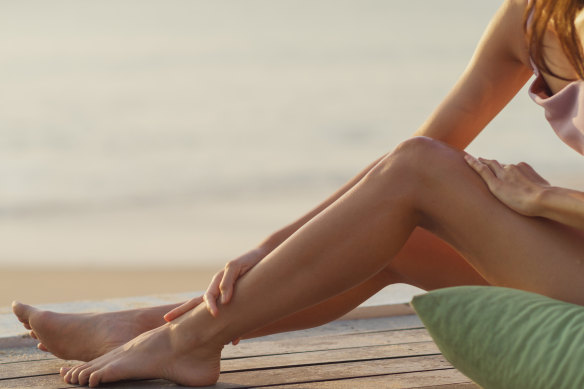This was published 9 months ago
There is only one type of safe tan. This is how to achieve it
Now we all know that ultraviolet radiation, whether from the sun or sun beds, is a hard no. According to the American Academy of Dermatology: “Evidence from multiple studies has shown that exposure to UV radiation from indoor tanning devices is associated with an increased risk of melanoma, the deadliest form of skin cancer, and non-melanoma skin cancer, including squamous cell carcinoma and basal cell carcinoma.”
Marion Eckert, professor of cancer nursing at the University of South Australia, has more to say. “The International Agency for Research on Cancer classed tanning beds as a Grade 1 carcinogen, the same category as cigarettes and asbestos, in 2009 … Solaria emit levels of UV radiation up to three times as strong as the midday summer sun.” No wonder I’m a zealot about UV damage. The truth is, if you’re getting a tan you’re also getting a significant amount of DNA damage.

To increase the longevity of fake tan, gently exfoliate every couple of days and moisturise daily.Credit: Getty Images
Despite this, and the subsequent ban, the Australian Science Media Centre reports that “collarium” sunbeds are being advertised for commercial use in parts of Australia. And it appears that collariums, which mix UV light with red light, can be just as damaging as sunbeds.
Dr Joseph Scott of the University of the Sunshine Coast, who has researched sun safety in Australian schools, says: “People should not be confused about sunbeds and cancer risks. Young people are at a particularly higher risk and need to be hypervigilant with protecting their skin as it’s thinner and more susceptible to UV radiation. The use of solariums before the age of 25 has also shown to be strongly associated with development of skin cancer. Prior to the ban on solariums in Australia, it was estimated that one in six melanomas in Australians aged 18 to 29 years would be prevented by abolishing sunbeds.”
However, for those who think they look better brown, there is always fake tan. As it can often cling to dry areas on your skin, make sure to apply a moisturiser every day in the week leading up to application. Then, 24 hours before, exfoliate to slough off dead skin and create a smooth base for the tan application, paying extra attention to feet, ankles, elbows and knees. We like St Tropez Prep and Maintain Tan Enhancing Polish and Exfoliator ($16).
Also undertake any hair removal at least 24 hours before fake tanning as self-tanners can sink into open pores, creating an uneven finish. Avoid deodorants and perfume as they can stain. Then, a couple of hours before tanning, moisturise very dry areas such as elbows, knees, ankles, feet and hands.
If you are applying a fake tan for the first time, try a mousse like St Tropez Self Tan Classic Bronzing Mousse ($36). Always apply with a mitt and allow the tan to dry before dressing; you can speed the process by running your hair dryer over your body, then rinsing off with cool water in the shower. The fake tan will continue to develop for another four to eight hours.
To increase the longevity of fake tan, gently exfoliate every couple of days and moisturise daily. You can also boost a fake tan with daily use of a body lotion such as Three Warriors Gradual Tan ($35).
ASK STEPH
Can a too-tight ponytail cause hair to fall out?
Yes. The medical term is “traction alopecia” and it’s caused by hair being pulled too tightly by things such as hair extensions, dreadlocks and “face-lifting” ponytails. The good news: if you catch the damage early it can be reversed, so watch out for stress pimples on the scalp.
Ask questions via Instagram, @mrssdarling.
Get the best of Sunday Life magazine delivered to your inbox every Sunday morning. Sign up here for our free newsletter.